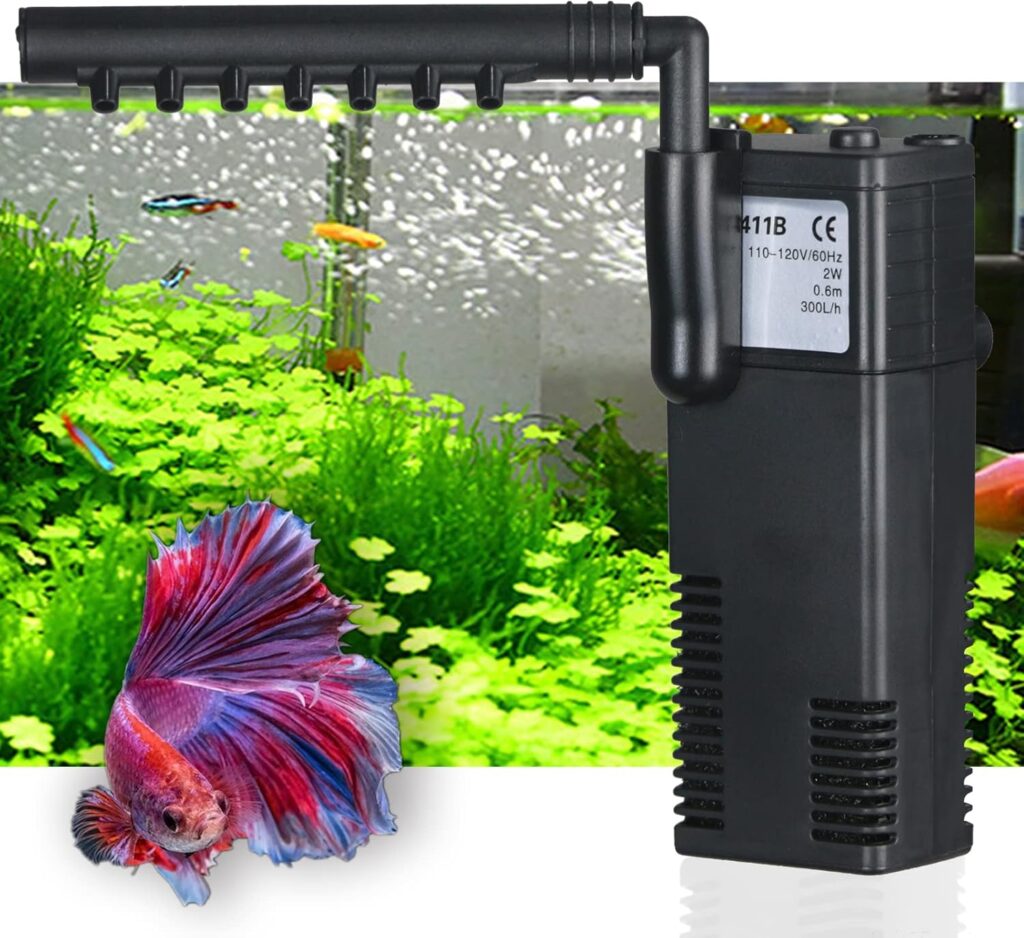When we think of aquariums, our minds usually jump to vibrant fish, bubbling plants, and peaceful water. But behind that serene setup is a silent worker—the fish tank filter—doing all the heavy lifting to keep the environment safe and clean.
Whether you’re a beginner or a seasoned aquarist, understanding fish tank filters is non-negotiable. They are crucial for removing waste, chemicals, and toxins, making sure your fish have a thriving and stable habitat.
In this comprehensive guide, we’ll dive deep into:
- Why fish tank filters are essential
- Different types of filters and their pros & cons
- How to choose the best one for your setup
- Maintenance tips and common mistakes
- Recommendations based on tank sizes and needs
Let’s begin.
Table of Contents
Why You Absolutely Need a Fish Tank Filter
A fish tank isn’t just a bowl of water with some fish. It’s a delicate ecosystem. Fish produce waste. Uneaten food decays. Algae grow. Without a fish tank filter, all these contaminants quickly build up, leading to cloudy water, foul smells, and potentially fatal ammonia spikes.
A well-functioning filter performs three critical types of filtration:
1. Mechanical Filtration | fish tank filters
This physically traps particles like leftover food, debris, and fish waste using sponges, pads, or floss.
2. Biological Filtration
Beneficial bacteria colonize your filter media and break down harmful ammonia into safer nitrates through the nitrogen cycle.
3. Chemical Filtration
Activated carbon and other resins help remove odors, discoloration, and dissolved toxins from the water.
A good fish tank filter handles all three of these tasks, creating a stable, balanced tank that requires less intervention and results in happier, healthier fish.
Types of Fish Tank Filters (And Which One You Should Choose)
Not all filters are created equal. Your tank size, fish type, and personal preferences all play a role in deciding what kind of filter you need.
Here’s a breakdown of the most common types:
1. Hang-On-Back (HOB) Filters
Best for: Small to medium freshwater tanks
Pros:
- Easy to install and clean
- Affordable
- Offers all three filtration types
Cons:
- Visible from the back
- May not be strong enough for large tanks
HOB filters are popular for a reason. They’re beginner-friendly and do a solid job for community tanks.
2. Canister Filters
Best for: Medium to large tanks, both freshwater and saltwater
Pros:
- Powerful multi-stage filtration
- Customizable filter media
- Quiet operation
Cons:
- More expensive
- Needs more effort to clean
If you’re serious about your tank or dealing with messy fish like cichlids or goldfish, canister filters are worth the investment.

3. Sponge Filters
Best for: Breeding tanks, shrimp tanks, hospital tanks
Pros:
- Gentle water flow (ideal for delicate fish)
- Excellent biological filtration
- Budget-friendly
Cons:
- Poor chemical filtration
- Not visually appealing
They’re not pretty, but sponge filters are extremely effective in specific situations—especially where strong currents are harmful.
4. Internal Filters | fish tank filters
Best for: Nano tanks, betta setups, small aquariums
Pros:
- Compact and simple
- Easy to install
- Good mechanical and biological filtration
Cons:
- Takes up tank space
- Limited filtration capacity
A solid pick for small tanks where space is at a premium and maintenance needs to be minimal.
5. Undergravel Filters
Best for: Old-school enthusiasts, basic setups
Pros:
- Hidden from view
- Promotes biological filtration
Cons:
- Hard to clean
- Limited mechanical and chemical filtration
These are becoming less common, but some aquarists still swear by them for specific setups.
How to Choose the Right Fish Tank Filter
Choosing the right fish tank filter depends on several important factors:
🐠 Tank Size
Larger tanks need stronger filters. As a rule of thumb, your filter should turn over the entire volume of your tank at least 4–6 times per hour.
Example: For a 30-gallon tank, look for a filter rated for 120–180 GPH (gallons per hour).
🐠 Fish Type
- Goldfish are messy and need strong filtration.
- Bettas prefer gentle flow.
- Saltwater fish require more robust systems due to complex water chemistry.
🐠 Budget & Maintenance
Canister filters are efficient but pricey and require more effort to clean. HOB filters offer a good balance for most hobbyists.
🐠 Noise Level
If your tank is in a bedroom or workspace, opt for quieter models like sponge filters or premium canisters.
Top-Rated Fish Tank Filters for Every Need
| Filter Type | Best For | Recommended Model |
|---|---|---|
| Hang-On-Back (HOB) | Beginners, community tanks | AquaClear Power Filter |
| Canister Filter | Large, high-bioload tanks | Fluval 407 Performance |
| Sponge Filter | Fry/shrimp tanks | Hygger Double Sponge |
| Internal Filter | Nano setups, betta tanks | Aqueon QuietFlow E |
| Undergravel Filter | Retro setups | Penn-Plax Clear-Free |
Each of these options provides different levels of filtration strength, media flexibility, and ease of use, helping you match the filter to your tank’s specific needs.
How to Maintain a Fish Tank Filter Properly
Even the best fish tank filters need regular maintenance to perform at their peak. But this doesn’t have to be complicated.
✅ Rinse Media in Tank Water
Never rinse filter pads or sponges in tap water—it kills beneficial bacteria. Use tank water during water changes.
✅ Replace Carbon Monthly
Activated carbon loses effectiveness after a few weeks. Replace it regularly if you’re using chemical filtration.
✅ Don’t Overclean
Avoid cleaning all components at once. This preserves your bacteria colonies and keeps the nitrogen cycle stable.
✅ Watch for Flow Drop
A noticeable drop in water flow usually signals a clog or dirty filter media.
Common Mistakes to Avoid | fish tank filters
Even experienced aquarists can run into trouble with fish tank filters. Here are pitfalls to avoid:
- Using the wrong size filter: Always choose one suited to your tank’s size and bioload.
- Skipping filter maintenance: Leads to poor water quality and stressed fish.
- Replacing all media at once: Disrupts the biological balance.
- Not cycling the tank: Your filter needs time to grow bacteria—don’t rush it.
Real-World Insight: What I Learned from a Filter Failure
A few years ago, I set up a 40-gallon tank with a budget HOB filter. Everything looked great for the first week. But then came cloudy water, stressed fish, and a sudden algae bloom. The culprit? A weak filter that couldn’t keep up with the tank’s needs.
After switching to a canister filter with customizable media, the transformation was night and day. Crystal clear water, stable parameters, and much happier fish. That experience taught me: never underestimate the importance of investing in the right fish tank filter.
Final Thoughts: The Unsung Hero of Your Aquarium
A filter might not be flashy. It won’t draw attention like colorful fish or lush plants. But it’s the reason your aquarium thrives. It’s the lungs, the kidneys, and the immune system of your aquatic world.
Choosing the right fish tank filter, maintaining it properly, and understanding its role in your tank’s ecosystem can mean the difference between frustration and long-term success.
So whether you’re setting up a simple betta bowl or a full-blown reef tank, treat your filter like the essential tool it is—because that’s exactly what it is.



